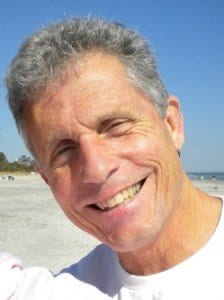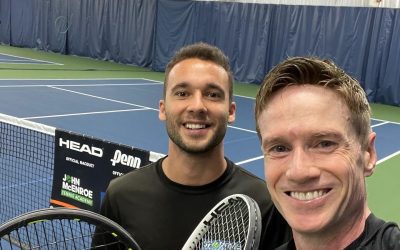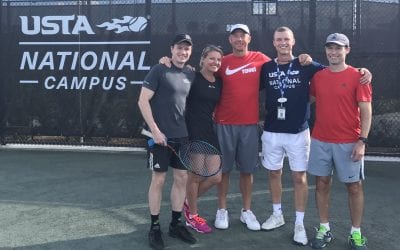Doing the Hard Work that Comes with Injuries (Guest Post)
Below is a guest post from fellow tennis fanatic Jim Falvo (in photo above doing medicine ball drill).
This post is a kind of “part 2” to my recent post “With Every Injury Comes An Opportunity“…
But it’s also “part 1” of a 3-part series of guests posts Jim will write in the months ahead to share his real-time experiences and emotions dealing with hip replacement surgery, which begins today.
I know you join me in wishing Jim all the best with the recovery process, and look forward to hearing back from him on all the progress!
P.J.
GUEST POST BY JIM FALVO
Dear Reader:
I’m scheduled for replacement of my right hip today (April 22). Too much tennis and running over the years led to loss of the pad between the head of the femur and its hip socket. I’m now 66 and formerly a 5.0 player. I most recently played USTA 4.0 doubles. I’ve also been a part-time teaching pro, certified by USPTA (although I’m presently inactive). I’ve also run 12 marathons, six half-marathons, and numerous 10K and 5K races. Did I mention that aerobics, spinning, and weight training have been a big part of my life? Gee, I wonder why my right hip is complaining!
Anyway, my surgeon is Dr. Phil Berry, one of the best in Dallas. He’s also the former #1 singles player for the University of Mississippi back in the late 1950’s. It was a stroke of luck to find him. He’s upbeat and positive about my recovery.
Another point of light who has provided encouragement is Bob Litwin – one of the top senior players in the world who has achieved tournament wins with an artificial hip! It shows what can be done with proper rehab and conditioning.
All of this tells me that I have a good chance of coming back better than ever. Yet how did this situation come about? What can we learn from my experience? Given my love of fitness and tennis in particular, it boils down to overuse. I have pounded my body for nearly 50 years and, although having a healthy diet and exercising properly (including stretching and rest), my genetics finally said “enough already!”
Unfortunately, the upcoming hip surgery isn’t my first challenge that affected my tennis game. Back in 1985, during a routine physical, a doctor discovered a malignant melanoma on my upper right chest. It had to be removed immediately to save my life. It was so invasive that I spent 11 days in the hospital. The operation left me with the inability to raise my right arm past shoulder height for nearly a year. Gradually I got full range of motion but it took about five years before I could serve with any power.
Then on March 13, 2006, I was chasing-down a tough crosscourt backhand when I inexplicably tore both quadriceps tendons. Shortly after I was injured, I found a blog of another person who suffered this “bilateral quadriceps tendon rupture.” Although he’s not a tennis player, I added my experience to his story which can be read by clicking here. By scrolling down past the halfway mark in his blog, the 3-18-07 entry describes my feelings one year after the rupture as I tried to hit tennis balls again. The full-length story of my injury can be found by clicking on Jim Falvo’s Amazing Story as part of that blog. Tennis Week later published my story in its July 16, 2009 edition.
As the above-mentioned blog reveals, it was 11 days after the surgery to re-attach my quad tendons to their respective patellas when I felt a heavy pressure in my chest as I started turning pale. I was thinking that my athletic body couldn’t be having a heart attack. Although I was correct, I was having a pulmonary embolism due to blood clots which had formed because I was not advised to move my legs which were in fully extended leg braces. I survived that episode but it set my recovery back at least a year.
It wasn’t until almost two years post-op that I dared to hit balls against the wall. It was over two years until I dared to use a ball machine and it was fully three years until I could hit with (not play) another person. During years 2-3, I lowered my 5K time from 48:15 when I first tried running to 24:37 at the end of year three. On good legs I had run a 5K in 22:15. Between years 3-4, I also managed to run two half-marathons, finishing both in about 2 hours, 25 minutes and two more in years 4-5 in about the same time. My previous best with normal legs was one-hour, 47 minutes. There would be no full marathons in my future but my PR of 3:48 back in 1993 was a close second to my wife’s best PR of 3:40.
About five years following the quad tendon rupture, I started playing social doubles with some very good senior players. I was regaining some foot speed and power that allowed me to compete in a USTA 4.0 league in 2013. I was enjoying tennis and managed to run a few more road races before another setback landed me in the hospital. As I was practicing my serve in late October 2013, I became short-of-breath and could not believe that yet another episode of blood clots could be threatening my life.
An emergency visit to the ER showed that the often-fatal saddle pulmonary embolism had formed in the upper lung airway, requiring me to be hospitalized immediately. Two doctors who visited my said that they had only seen this condition in the autopsy room! Yes, indeed, I had dodged another bullet but another challenge was just around the corner. My right hip had started really hurting on certain movements in late 2013 and I knew I could no longer ignore the pain. X-rays revealed bone-on-bone in the right hip socket with the left one not being too far behind.
This takes me to today as I prepare for right hip replacement surgery in 48 hours. I have a positive attitude to adapt and overcome this challenge but realize I’m in for another long rehab. That said, my surgeon expects me to try walking four hours after leaving the recovery room! The last thing he wants to see is another episode of blood clots. To avoid that outcome, I’ll need to be sure I stick to a daily regimen of exercises that promote healing without threating the integrity of the new hip.
As I reflect on my journey through life, I realize that living is a lot like a typical tennis match. You employ the tools that are presently at your disposal and engage the opposition while battling other challenges. In the final analysis, you control what you can, accept what you cannot, hope for the best, prepare for the worst, and be thankful that you are alive and able to compete no matter what the outcome. My mantra has become what peak performance expert Ed Tseng posits: “thoughts determine feelings and feelings determine behavior.”
The struggles of a tennis match and life itself is also summed-up nicely in a famous quote by Teddy Roosevelt that I’ll close with and report back on the results of the surgery.
“It is not the critic who counts; not the man who points out how the strong man stumbles, or where the doer of deeds could have done them better. The credit belongs to the man who is actually in the arena, whose face is marred by dust and sweat and blood; who strives valiantly; who errs, who comes short again and again, because there is no effort without error and shortcoming; but who does actually strive to do the deeds; who knows great enthusiasms, the great devotions; who spends himself in a worthy cause; who at the best knows in the end the triumph of high achievement, and who at the worst, if he fails, at least fails while daring greatly, so that his place shall never be with those cold and timid souls who neither know victory nor defeat.”
Remember to make each day count!
Jim Falvo
Dallas, TX
Feel Free to reach out to me directly at roadto45@gmail.com and be sure to follow me on social media!





Amazing story Jim, and I hope you’ve gotten back to 100% in the years since this article. My grandparents met playing tennis, and they played long into their 70s. You got many more good years to go my friend!
Yes that’s true I am practicing 5 to 6 hours per day it makes me more comfortable to play tennis games.
Thanks for sharing this real-life struggling story, Jim. I have well known that every sportsman has a huge injured risk & many of them fall down it. But most of them not to recover & not to come back again. The world many famous athletics life are ruined by this. I already motivated to read your story.
This is a nice story, Jim. When I had an injury, I almost couldn’t play any game and even any active exercise. Yes, totally agree “thoughts determine feelings and feelings determine behavior”. If you have a good mind, it helps you overcome the injury more easily
Such an inspiring journey of recovery, Jim. It’s amazing the capability that the human body has to repair itself. One thing that first got me into tennis was the fact that it was a life long sport. It always pays to be careful and deal with injuries as they first make an appearance instead of waiting until it’s possibly too late.
Thanks for sharing your story and learnings, Jim.
Love the quote, walk past a bust of Teddy everyday at work, with this exact quote underneath it. Always take a pause in my stride to take it in and feel motivated. Even before a tennis game, I look at it on my phone and remind myself of the ‘why’ and ‘for what’. This quote really has become the motto for my USTA team.